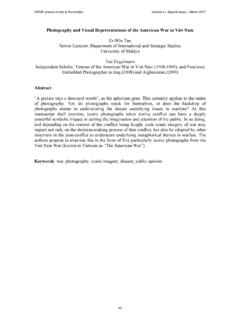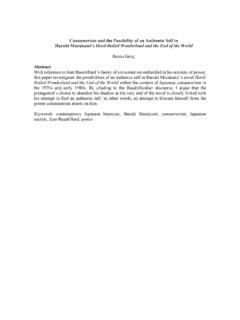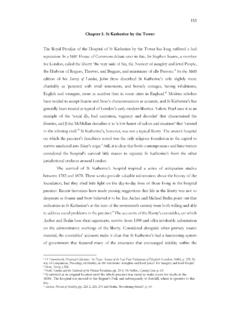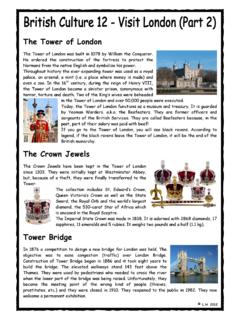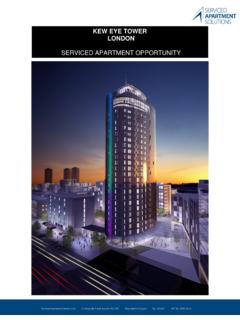Transcription of “Braving the London fog”: Natsume Sōseki’s The Tower of ...
1 braving the London fog : Natsume S seki s The Tower of London Andreas pichler Abstract S seki s encounters with London during his two years stay from 1900 to 1902 were for the first time published in the English language under the title The Tower of London in 2005. Fog as a material meteorological substance and as a literary metaphor not only occurs frequently in his stories but is tied to question of darkness when depicting London on the brink of modernity at the turn of the last century. This article is guided by a form of critical literary analysis that draws on a meteorological concept in an attempt to link literature and fog, the British capital and modernity, and the innovative approach of a Japanese encountering the foggy maze of late-Victorian London . The investigation into the meteorological aspects of fog to comprehend S seki s fog-like light will shed some light upon a possible process of rendering the darkness gradually brighter.
2 Keywords: London fog, S seki, The Tower of London , cultural and geographic alienation, modernism The IAFOR Journal of Literature and LibrarianshipVolume 2 - Issue 1 - Spring 201357 I am again standing all alone thinking in the darkness (S seki, p. 148): This enigmatic claim seems to capture how Natsume S seki was experiencing his two years stay in London from 1900 to 1902. Sent to England on a Japanese government scholarship in 1900, S seki arrived in the British capital on 28 October and moved in at 76 Gower Street in the Bloomsbury District just north of the British Museum. Life in England and in London for S seki was characterised by profound historical and cultural changes, marked by Queen Victoria s death on 22 January 1901 and London s emergence as the world s leading metropolis.
3 S seki developed a deep admiration for the British literature and the arts during his stay: Many things have caught my attention: how literature and the arts are flourishing in this country and how the flourishing of literature and the arts is influencing the national character (S seki, p. 53). But while English literature and art exerted a positive influence on him, the sheer vastness of the cityscape fed a psychological and creative anxiety. His poor English skills were in part responsible for this anxiety, his difficulty to grasp the dimension of the urban sprawl furthermore reinforced his feeling of angst. Malcolm Bradbury points out that London was this was part of its essential attraction the world s largest city, still expanding with extraordinary rapidity, generating a remarkable cityscape and a fascinating technology (Bradbury, p.)
4 179). In a Letter from London S seki writes: but London is so vast that it is hard to know how far it spreads (S seki, p. 65). He would only later be able to reconcile in his writing the psychological and somatic unease encountered in the British capital s infinity. As Flanagan observes: Yet it was London that was to be the crucible and crossroads of his life, the place where S seki was faced with the intense cultural shock and social alienation that led to the eventual tumultuous release of his pent-up creative urges (Flanagan 2005, p. 11). S seki s alienation seems to point to a much deeper feeling of uneasiness within a renewed set of spatial and cultural contexts shaped by modernism s intrinsic relationship with materiality, science, spatiality and technology.
5 S seki pictures London as the workshop of the world (S seki, p. 62) and notices to what extent this country s development has advanced materially (S seki, p. 53). It is pivotal therefore to come to terms with the origins of this uneasiness and anxiety that orient this article s focus on S seki s collection of autobiographical short stories entitled The Tower of London1, which were put on paper upon his return to Japan in 1903. The eleven short stories dealing with his experiences in the British capital were published for the first time in Great Britain in 2005 under the title The Tower of London and consist of three parts: Letter from London (1901) and Bicycle Diary (1903) published in the magazine Hototogisu (The Cuckoo), the stories The Tower of London and The Carlyle Museum (1909) included in the volume Yokyoshu (Drifting in Space), and a selection of short stories such as A Warm Dream , Impression , Fog and Long Ago from Eijitsu Shohin (Short Pieces for Long Days) printed for the first time in 1909 in the Asahi newspaper.
6 S seki s textual relationship with the vastness, darkness, and fogginess of London leads to the main claim of the article. At its source lies a feeling of geographical displacement within the urban landscape: At that time I hardly knew one direction from another and, of course, knew nothing at all about geography (S seki, p. 91). Equally discomforting, the cultural differences lead to an estrangement: rather than happy, I have a feeling of indescribable 1 Natsume S seki s The Tower of London was translated from the Japanese by Damian Flanagan. All quotes are from the same edition. ISBN 0 7206 1234 9. The IAFOR Journal of Literature and LibrarianshipVolume 2 - Issue 1 - Spring 201358 strangeness (S seki, p.)
7 126). In the following pages I will shed some light upon S seki s disorientation and feeling of deracination in the British capital. Angela Yiu s insightful notion of a dark, romantic voice in Order and Chaos in the Works of Natsume S seki (Yiu, p. 1) is linked to her portrayal of chaos in S seki s novels. If we agree at all with this analysis, then it is logical to find strands of chaos and darkness in all of his works, including the short stories linked to the British metropolis. What Yiu terms as chaos in S seki s works refers to something cavernous and amorphous, like an unidentifiable fear or a formless anxiety, that threatens to overtake reason and self-control (Yiu, p. 2). How does this formless anxiety manifest itself for S seki in London ? How did a London on the brink of modernity represent this cavernous entity?
8 Interdisciplinary and intercultural research have not yet stressed the link between something undefinable, energetic and powerful (Yiu, p. 2) present in such works as Kokoro and K jin and his stories on London . Very little research has been done on these eleven accounts written mostly between 1903 and 1909. His encounters with the London fog reside at the heart of S seki s cavernous fear and formless anxiety. But why the fog, one might ask. In most of his works, S seki does not depict urban landscapes in conjunction with fog, notably in the novel Kokoro, in which Tokyo appears under a clear blue sky: I intended of course to visit Sensei when I returned to Tokyo. [..] The atmosphere of the great city affected me a great deal [..]. It was a lovely day, and the sky was so blue that I was filled with a sense of well-being (S seki, Kokoro p.)
9 8-9). The feeling of well-being conveys a stunning contrast to the oppressiveness he experienced in London . One is indeed tempted to wonder whether fog conveys more than just a material substance intrinsically linked to the topography of the British landscape. Fog, I argue as a material meteorological substance and as a literary metaphor not only occurs frequently in his stories but is tied to question of displacement and loneliness that characterize S seki s London at the beginning of last century. This article is, therefore, guided by a form of critical literary analysis that draws on a meteorological concept and focuses on the trope of fog. Fog as a meteorological phenomenon exercises its influence on the immediate environment in that the misty mass invades human space enshrouding the local physical geography.
10 Fog unveils its own dynamics due to its characteristics of formlessness (fog has no definite or consistent spatial form), content-lessness (apart from the water particles in the air) and site-lessness (no specific geographic location). There is no beginning nor end for fog forms and dissolves along the lines of its own fluctuation. Fog acts like a self-vibrating region with its own intensities because its substance white, empty and colourless relies on the vibration of the water particles constituting its own energy. S seki s evocation of behaving like water particles unveils a first link to fog s formlessness. In the short story entitled A Warm Dream S seki describes the grim attitude of the Londoners while strolling through the streets lined by high-rise buildings.
